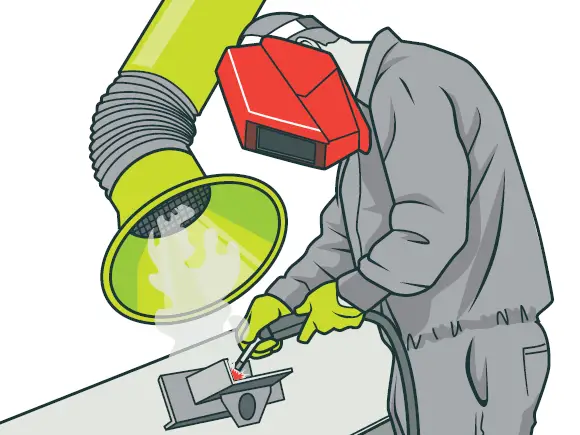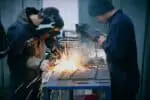Welding is a tough job but along with it, it has some serious complications on your health too.
The level of hazard and exposure to welders is determined by the type of work being performed, the different welding rods, its filler metals, base metals, coatings, impurities, and the quantity of ventilation and breathing protection that is available.
It is essential for welders to wear masks given the nature of their work. They understand that the gases and chemicals released by welding will protect their face, eyes, and neck from a range of potentially harmful fumes, and also heat and sparks, UV and infrared light.
Why Do You Need To Wear Masks When Welding?
Here we give you reasons why you need to wear masks while welding.
1.) To protect your yourself from severe burns
Welding is the process of modifying metals and other materials at extremely high temperatures. To put this in context, it requires way less heat to burn a human skin.
Metals may be heated to several times that temperature with a welding torch. This implies that if molten slag falls on your naked face, you will end up with painful scars that are permanent.
2.) To reduce the chances of respiratory issues
Acute exposure to welding fumes and gases can cause irritation of the eyes, nose, and throat, as well as dizziness and nausea.
If anyone experiences these symptoms, they should leave the area immediately and seek some fresh air. Also, if difficulty in breathing or any above mentioned symptoms persists, they should seek medical assistance immediately.
Prolonged exposure to welding fumes can cause lung damage as well as cancers of the lungs, throat, and urinary system.
A condition called ‘Asphyxia‘ can occur when gases such as helium, argon, and carbon dioxide replace oxygen in the air and cause suffocation, especially while welding in tight or enclosed places.
3.) To protect your eyes from harm
The most serious concern posed by welding without a mask is the multiple threats to the welder’s eyes.
In addition to being exposed to flying particles, unpleasant gases, and any splatter from the weld pool, a welder who does not cover their eyes from an arc welding flame risks developing photokeratitis (also known as welder’s flash or arc eye), which is a painful ailment.
Welders who routinely expose their eyes to a welding flame without UV protection run the danger of creating cumulative eye damage. This exposure can result in irreversible blindness over time.
4.) To protect you from long term skin cancers
The same high-intensity UV exposure from a welding torch that can cause an arc eye when not using a welding mask can also induce UV damage to the skin.
Cumulative exposure to UV radiation from a welding torch, which may harm the eyes, can also soak into the skin’s surface.
Skin malignancies, which are the most frequent type of cancer in the US, are particularly deadly due to their tendency to spread to other organs of the body.
See also: Do Welding Helmets Protect From UV?
How Can You Protect Yourself From Injuries And The Harmful Welding Fumes?
1.) Make use of Local Exhaust Ventilation (LEV)
If you must weld in your workplace, employ exhaust ventilation equipment for indoor operations that can help reduce the amount of fumes. This process is also known as fume control or extraction.
This will shield the welder from welding fumes. It will also assist to protect others around you.
2.) Wear appropriate Respiratory Protection Equipment (RPE)
If LEV alone cannot offer effective control, or if providing LEV is not reasonably possible, you must supply proper respiratory protection equipment to your workforce (RPE).
For example, if they are welding with LEV but not all of the fume is caught, you may be able to see leftover fumes, which means you are not limiting the danger and should supply respiratory protection equipment.
3.) Try to avoid or limit your exposure.
To safeguard yourself from the health concerns associated with welding fume inhalation, consider some other method that can be employed if it means it will result in lesser fumes and harmful gases.
Use materials or a procedure that emits fewer fumes, such as MIG welding (an arc welding process) instead of MMA welding (stick welding).
According to OSHA
American workplaces are held to the Department of Labor’s Occupational Safety and Health Administration (OSHA) safety requirements.
Similar requirements are in place in most areas across the world to ensure that welders are protected on the job by PPEs.
Welders should be aware of the dangers of the materials they deal with. Employers are required by OSHA’s Hazard Communication requirement to provide workers with information and training on hazardous products in the workplace.
Welding surfaces should be cleaned of any covering that might cause dangerous exposure, such as solvent residue and paint, and employees should be positioned to avoid breathing welding fumes and gases.
Recommended Welding Masks / Respirators
1.) Breath Buddy Respirator Mask
- ✅GET EXTREME PROTECTION
- ✅ REUSABLE MASK
- ✅FITS PERFECTLY
- ✅CRYSTAL CLEAR VISION
- ✅ZERO ODORS GUARANT
Prices pulled from the Amazon Product Advertising API on:
Product prices and availability are accurate as of the date/time indicated and are subject to change. Any price and availability information displayed on [relevant Amazon Site(s), as applicable] at the time of purchase will apply to the purchase of this product.
What truly distinguishes this mask is its extreme comfort. It has a filter efficiency of 95%, odor removal and is super comfortable.
2.) 3M Half Facepiece Respirator
- COMFORTABLE
- DURABLE and REUSABLE
- HELPS REDUCE EXPOSURE
- USE WITH OTHER PPE
- NIOSH approved
Prices pulled from the Amazon Product Advertising API on:
Product prices and availability are accurate as of the date/time indicated and are subject to change. Any price and availability information displayed on [relevant Amazon Site(s), as applicable] at the time of purchase will apply to the purchase of this product.
These masks with its provided filters, performs admirably against welding fumes, which is unquestionably a significant benefit in this tough profession.
It has filters, which saves you both time and money. It’s also one of the more comfy respirators on the market, making it ideal for long-term welding work.
3.) GVS Elipse P100 Mask Respirator
- Range of extremely light masks (130g)
- A unique and low profile filter
- Low breathing resistance
- NIOSH Approved TC-84A-6949
- Made from soft thermoplastic elastomer
Prices pulled from the Amazon Product Advertising API on:
Product prices and availability are accurate as of the date/time indicated and are subject to change. Any price and availability information displayed on [relevant Amazon Site(s), as applicable] at the time of purchase will apply to the purchase of this product.
Its distinguishing characteristic is its form factor, which is significantly smaller than that of most other respirators. This allows it to fit easily behind most welding masks.
It is also reasonably priced, and if you’re seeking for a tiny, effective, and lightweight respirator, there isn’t a better option on the market for the price.
Conclusion
Because there are so many things that may go wrong while welding without a helmet, this is necessary for any size or style of welding operation.
Welders do wear a lot of protective gear, but in many ways, their mask is the most vital.
They protect you not only from heat and sparks, but also from UV and infrared radiation, fumes, and numerous chemicals that are constantly present in every welding project.











